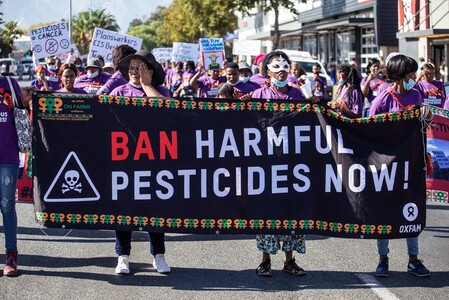To: Minister of Agriculture John Steenhuisen, South African Department of Agriculture,
Ban Deadly European Pesticides from South African Soil

Five years ago, Women on Farms Project (WFP) launched its Double Standards Pesticides Campaign, which initially targeted the South African government, demanding it ban 67 Highly Hazardous Pesticides (HHP's) already banned in the European Union.
Today, the EU continues to produce and export countless HHP's to South Africa, even though these pesticides are banned for use on their own soil due to their often deadly health effects on exposed farm workers and communities.
After 5 years of advocacy and many failed promises by the South African government to end the double standard and ban these deadly pesticides, many HHP's are still widely used across South Africa. Exposure to these pesticides can cause respiratory distress, endocrine disruption, cancer, and even death in exposed populations.
The lives of South African farm workers matter, and we demand that the Department of Agriculture immediately place a comprehensive ban on the import and use of all highly hazardous pesticides. This ban is long overdue and is evidence of the way in which the world continues to value European lives more highly than those of Africans.
Today, the EU continues to produce and export countless HHP's to South Africa, even though these pesticides are banned for use on their own soil due to their often deadly health effects on exposed farm workers and communities.
After 5 years of advocacy and many failed promises by the South African government to end the double standard and ban these deadly pesticides, many HHP's are still widely used across South Africa. Exposure to these pesticides can cause respiratory distress, endocrine disruption, cancer, and even death in exposed populations.
The lives of South African farm workers matter, and we demand that the Department of Agriculture immediately place a comprehensive ban on the import and use of all highly hazardous pesticides. This ban is long overdue and is evidence of the way in which the world continues to value European lives more highly than those of Africans.
Why is this important?
This campaign is important because thousands of vulnerable farm workers in South Africa are impacted by exposure to Highly Hazardous Pesticides daily. Farm workers are often made to work in fields with none of the necessary protective gear and frequently have pesticides sprayed over them. As a result, of their exposure to pesticides, many farm workers have been reported to have developed severe asthma, stomach or womb cancer, and other lethal conditions. These conditions go on to prevent farm workers from being able to work and therefore feed their families.
This is why these highly hazardous pesticides are banned from use in the European Union, but unfortunately, due to double standards and weak South African legislation, they are still exported and used on mass across South Africa.
This is why these highly hazardous pesticides are banned from use in the European Union, but unfortunately, due to double standards and weak South African legislation, they are still exported and used on mass across South Africa.
.png)
